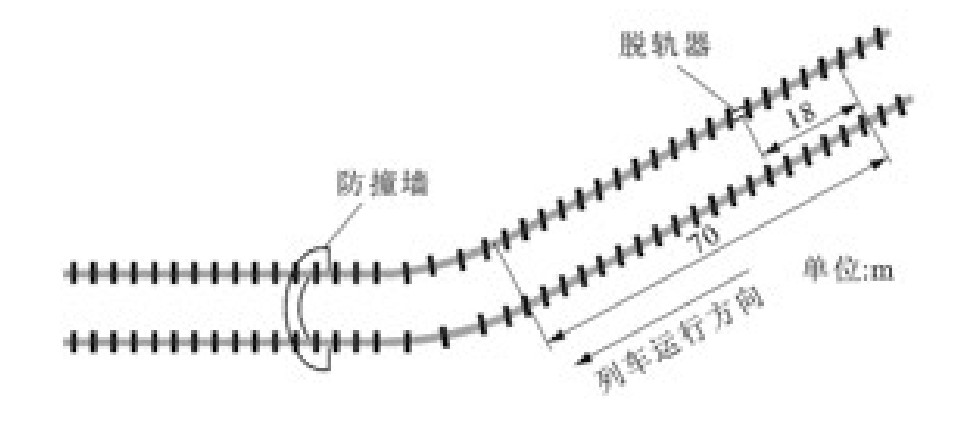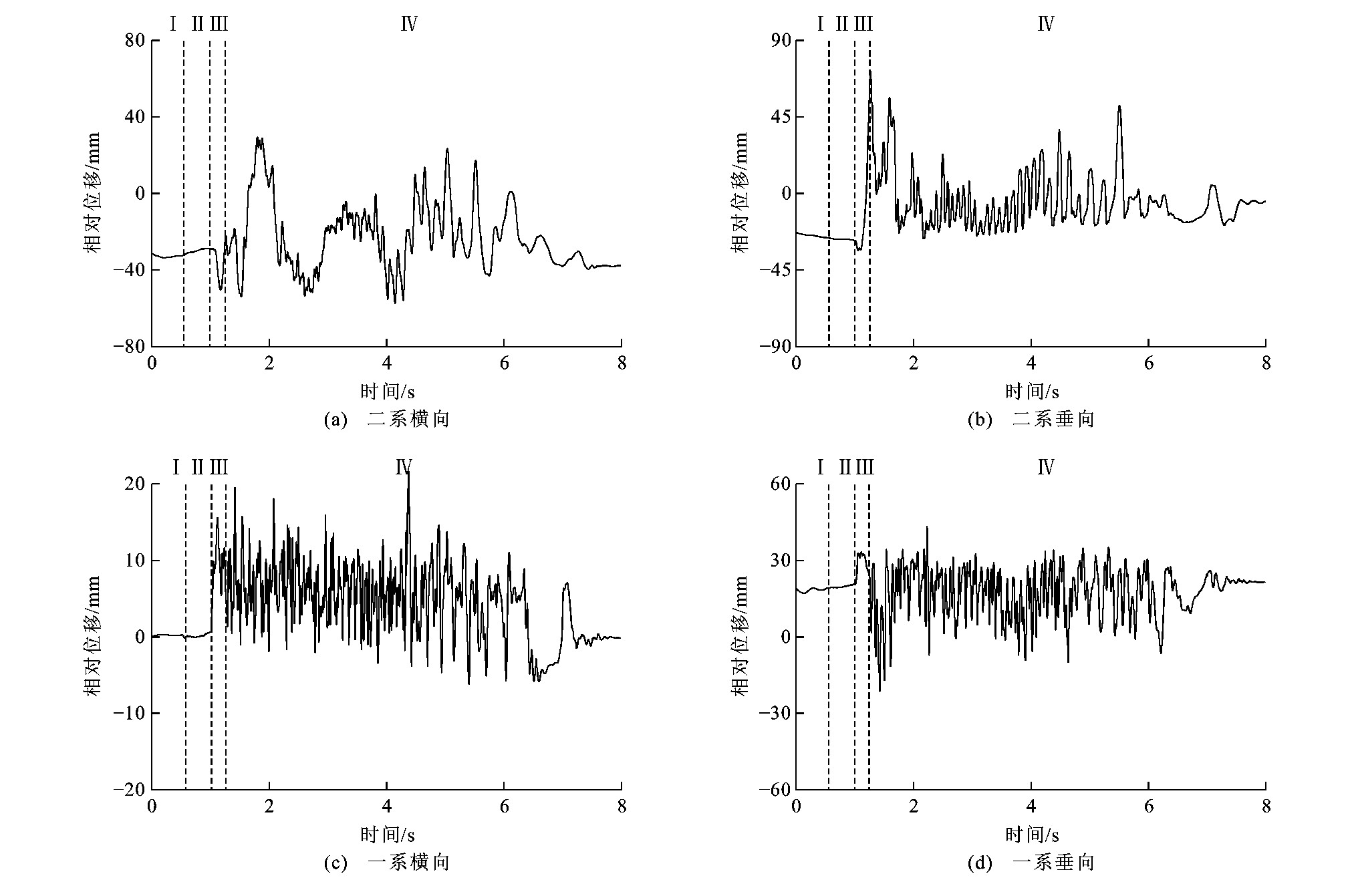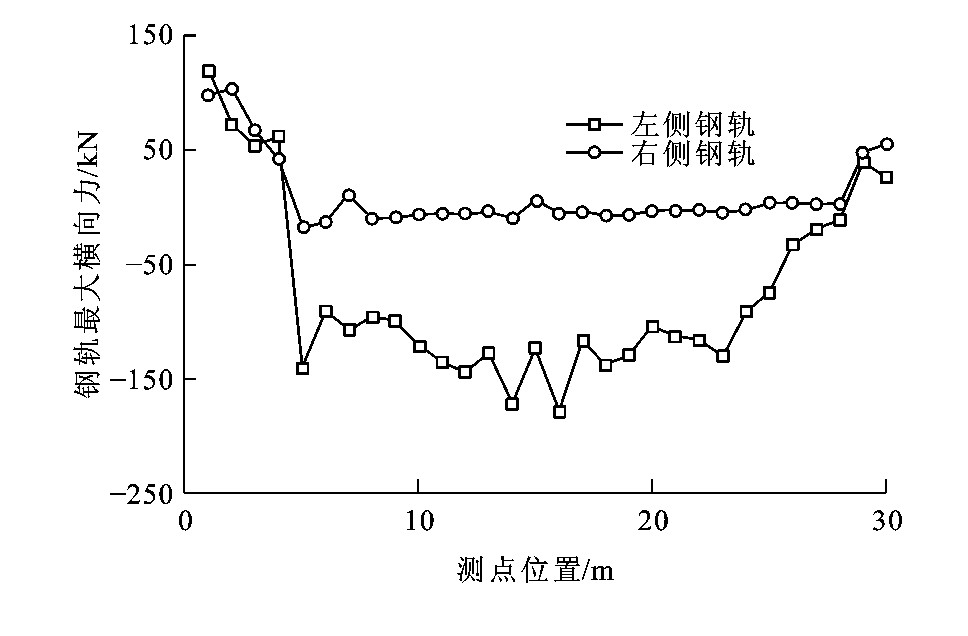Dynamic responses of motor vehicle in low-speed derailment
-
摘要: 在动车轴箱下方安装防护装置, 进行线路低速脱轨试验。车辆借助脱轨器完成脱轨, 利用应变片、加速度和位移传感器采集脱轨车辆的动态响应, 采用高速摄像仪和视频摄像仪分别记录了脱轨车辆的运动姿态。基于试验数据, 评估了脱轨条件下钢轨抗倾翻能力, 验证了脱轨安全防护装置的性能, 分析了动车脱轨后的动态响应和脱轨速度、车辆质量和线路对动态响应的影响。试验结果表明: 当动车低速脱轨时, 防护装置撞击钢轨的最大横向力为177.18kN, 小于钢轨横向抵抗力510.00kN, 因此, 脱轨安全防护装置可以扣住钢轨外侧, 有效限制脱轨车辆的横向移动。车辆的脱轨过程分为惰行、轨上运动、落地和路基滑行4个阶段, 各阶段的动态响应均随脱轨速度和车辆质量的增大而增大。当动车脱轨速度为22km·h-1时, CRTSⅡ型双块式无砟轨道的脱轨距离约为15.80m, CRTSⅠ型板式无砟轨道的脱轨距离约为20.87m, 因此, CRTSⅡ型双块式无砟轨道的轨枕可以起到减速带的作用, 减小脱轨距离。Abstract: The low-speed derailment experiment of signal motor vehicle with post-derailment safety device under axle box was carried out.The derailer was installed on the rail to force the vehicle to derail.Acceleration sensors, displacement sensors and strain gauges were used to detect the dynamic responses of derailed vehicle.The motion attitude of derailed vehicle was recorded by using high-speed cameras and surveillance cameras.According to the test data, the ability of overturning resistance for rail and the performance of derailment safety device were verified.The dynamic responses of derailed vehicle and the effects of derailment speed, vehicle mass and track on the responses were studied.Test result indicates that in low-speed derailment, the biggest lateral force between rail and post-derailment safety device is 177.18 kN that is less than the lateral resistance of 510.00 kN, so the post-derailment safety device has the ability to limit the lateral displacement of derailed vehicle by catching the outside of rail after derailment.The derailment process is divided into four stages, including idling, running on the derailer, falling and coasting on the track, at which the dynamic responses of derailed vehicle are increasingwith the increase of derailment speed and vehicle mass.When derailment speed is 22km·h-1, the derailment distance of CRTSⅡ bi-block sleepers ballastless track is about 15.80 m, while that of CRTSⅠ slab ballastless track is about 20.87 m.Accordingly, the bi-block sleepers of CRTSⅡ bi-block sleepers ballastless track resemble the speed bump and decrease the derailment distance.
-
0. 引言
城市道路交叉口和公路交叉口以及中国城市道路交叉口和国外城市道路交叉口的主要区别之一就是中国城市道路交叉口处具有较多的非机动车和行人, 非机动车和行人的存在对机动车的通行产生了较大的影响。目前, 有较多学者对城市道路交叉口处非机动车和行人的运行特征进行了分析。Raksuntorn对信号交叉口自行车的到达分布进行了研究[1]; Kim研究了信号交叉口处行人和机动车的冲突特征, 并提出通过信号配时的方法消除两者之间的冲突[2]; Elbadrawi分析了环行交叉口处非机动车和行人与机动车的冲突特性, 并建立了计算机模拟模型来分析行人、自行车和机动车之间的相互影响[3]; Akin对信号交叉口处行人和右转车辆之间的冲突状况进行了研究, 并对两者之间的相互影响利用回归分析技术进行了分析[4]; HCM2000对交叉口处的行人交通流运行特性及其对机动车交通流的影响进行了分析[5]; Taylor对自行车和汽车的混合交通行为进行了分析, 采用离散选择概率模型描述了机动车驾驶人和骑车者的间隙接受行为[6]。国内学者中, 徐良杰分析了自行车通过交叉口时的膨胀模型和消散模型, 并分析了行人交通流特性[7]; 池利兵对信号交叉口处自行车交通流的运行特性和流量特性进行了分析[8]; 赵建丽对混合交通条件下信号交叉口的行人交通状况进行了研究[9]; 刘珈铭对信号交叉口处自行车的到达分布模型进行了研究[10]; 陈吉发以行人和非机动车群为研究对象, 得到行人和非机动车群的到达空隙符合移位负指数分布[11]。另外, 徐良杰等还对城市道路交叉口处机动车和行人之间以及机动车和非机动车之间的冲突状况进行了分析[12]; 陈晓明等对城市道路交叉口处非机动车和行人对机动车通行能力的影响进行了分析[13]; 赵建有等从对城市道路交叉口进行安全评价的角度出发, 对城市道路交叉口处机动车和行人之间的冲突状况进行了分析[14]。
上述研究中, 大部分将非机动车和行人单独进行了分析。然而观测表明, 非机动车和行人在通过交叉口的过程中, 彼此之间往往存在着重叠交叉的现象, 非机动车和行人共同以“当量人群”的形式对机动车的通行产生影响。对当量人群的运行特性进行分析将为城市道路交叉口的深入研究打下基础。
1. 当量人群的定义
通过对城市道路交叉口的非机动车流和行人流进行观测发现, 非机动车和行人在通过交叉口的过程中并不遵循固定的轨迹, 它们往往是杂乱无章地在道路上行走, 相互之间还存在着叠加现象。另外, 机动车在穿越非机动车流和行人流时一般也是寻找两者的共同间隙一次完成穿越, 很少存在二次穿越的情况, 因此, 本文将非机动车和行人流作为一个整体进行分析, 定义一个“当量人群”的概念来描述它们对机动车流的共同影响, 其中非机动车包括自行车和电瓶车。
以道路某一横断面为参考线, 如果在某一时间段内该断面没有非机动车和行人通过, 就将这个时间段定义为一个间隙, 相应的2个间隙之间的非机动车和行人就定义为一个当量人群, 见图 1。
由上述定义, 2个相邻间隙之间的非机动车和行人被认为是一个当量人群。假定当到达交叉口处的非机动车和行人的前后时差超过tpb时, 该部分非机动车和行人被算作一个当量人群。tpb定义为前后到达的两当量人群的最小间隙值, 即划分当量人群的最小间隙值, 该值与到达交叉口的非机动车和行人流量以及交叉口的实际运行状况有关。通过对高峰小时到达交叉口的当量人群进行观测以及对机动车穿越当量人群时的穿越间隙进行分析, 可取最小间隙tpb为1 s。
2. 当量人群群时距分布
定义群时距为2个相邻的当量人群之间的时间距离, 即2个相邻的当量人群之间的间隙值。
通过对河南省平顶山市开源路-优越路交叉口西进口人行横道的高峰小时当量人群进行统计, 共得到当量人群群时距样本407个, 将其划分为20个子区间, 组距为1 s, 各区间样本频数见表 1, 样本直方图见图 2。
表 1 群时距统计值Table 1. Statistical values of group time headways区间 < 2 3 4 5 6 7 8 9 10 11 12 13 14 15 16 17 18 19 20 > 20 频数 55 63 56 38 35 21 21 25 12 11 16 8 8 4 5 5 4 2 3 15 由样本直方图 2, 假设城市道路交叉口当量人群的群时距服从移位负指数分布, 利用χ2检验法对该假设进行检验。通过对调查数据进行分析, 当量人群的群时距平均值为6.63 s, 对当量人群群时距服从移位负指数分布的假设检验结果表明
χ20.05(15)=24.996>13.507
得开源路-优越路交叉口西进口当量人群群时距服从移位负指数分布。
对平顶山市优越路-劳动路交叉口南进口、曙光街-光明路交叉口东进口的当量人群群时距分布进行相同的假设检验, 检验结果表明, 当量人群的群时距均服从移位负指数分布。
3. 当量人数与群时距和群个数关系
定义“当量人数”为根据自行车、电瓶车和行人间的换算系数值[15], 即Cb、Ce、Cp分别为1.67、1.58、1.00, 将自行车和电瓶车换算为行人后的“人数和”。按照前述对当量人群的定义, 定义“群个数”为指定时间段内当量人群的数目。
考虑到样本的稳定性、样本量的大小以及应用的便利性, 下述分析中将时间段定为15 min, 通过对各15 min时段的当量人数、平均群时距以及群个数的统计分析, 研究当量人数与群时距和群个数的关系。
3.1 当量人数与群时距关系
通过对曙光街-光明路交叉口、开源路-优越路交叉口、优越路-劳动路交叉口的当量人群进行调查, 共得到15 min样本45个, 见表 2, 每个样本代表的都是15 min时段的当量人数和该15 min时段的平均群时距。对这些样本利用一元线性(Linear)、二次函数(Quadratic)、复合函数(Compound)、生长函数(Growth)、对数函数(Logarithmic)、三次函数(Cubic)、S形曲线(S)、指数函数(Exponential)、逆函数(Inverse)、幂函数(Power) 和逻辑函数(Logistic) 进行回归分析, 分析结果见表 3和图 3。
表 2 15 min时段当量人数与平均群时距统计值Table 2. Statistical values of equivalent people numbers and average group time headways in 15 min当量人数 330.78 349.18 321.17 348.49 351.77 266.51 407.43 343.57 272.15 平均群时距/s 6.38 5.98 6.54 5.77 6.17 8.89 5.65 6.43 7.75 当量人数 328.45 340.61 339.83 333.73 330.14 411.29 288.89 274.80 343.74 平均群时距/s 6.09 6.30 6.35 5.82 7.40 5.60 7.36 6.86 6.12 当量人数 338.11 343.09 342.81 365.18 392.30 275.03 670.13 453.34 360.92 平均群时距/s 6.31 5.94 5.98 5.94 6.01 7.35 4.21 5.10 5.76 当量人数 274.13 537.40 424.67 327.48 452.21 401.29 309.58 1 142.65 1 221.27 平均群时距/s 6.86 4.82 5.45 6.18 5.15 5.49 6.61 3.37 3.74 当量人数 680.99 437.11 1 265.52 1 035.80 507.59 440.26 1 334.80 778.95 492.47 平均群时距/s 4.24 5.74 3.42 3.75 5.36 5.88 3.51 4.09 5.50 表 3 15 min时段当量人数与平均群时距回归分析结果Table 3. Regression analysis results between equivalent people numbers and average group time headways in 15 min回归方程 模型概述 参数估计 R2 F d1 d2 S C b1 b2 b3 一元线性 0.725 113.428 1 43 0.000 7.484 -0.004 对数函数 0.842 228.496 1 43 0.000 20.808 -2.483 逆函数 0.905 408.498 1 43 0.000 2.342 1 356.005 二次函数 0.867 137.489 2 42 0.000 10.172 -0.013 6.44×10-6 三次函数 0.891 112.105 3 41 0.000 12.752 -0.027 2.77×10-5 -9.55×10-9 复合函数 0.832 212.755 1 43 0.000 7.950 0.999 幂函数 0.919 490.147 1 43 0.000 106.412 -0.485 S形曲线 0.936 627.543 1 43 0.000 1.079 257.724 生长函数 0.832 212.755 1 43 0.000 2.073 -0.001 指数函数 0.832 212.755 1 43 0.000 7.950 -0.001 逻辑函数 0.832 212.755 1 43 0.000 0.126 1.001 注: F为F检验值; d1、d2为自由度; S为F检验值的实际显著性水平; C为常数项; b1、b2、b3为回归参数。 综合考虑这11种回归曲线的判定系数R2值和各模型的应用便利性, 最后选择逆函数(Inverse) 对当量人数与群时距的关系进行描述, 表达式为
yt=2.342+1356.005/x200≤x≤1400 (1) 式中: yt为15 min时段平均群时距(s); x为15 min时段当量人数。式(1) 判定系数R2为0.905。
3.2 当量人数与群个数关系
通过对曙光街-光明路交叉口、开源路-优越路交叉口、优越路-劳动路交叉口的当量人群进行调查, 共得到15 min样本45个, 见表 4, 每个样本代表的都是15 min时段的当量人数和该15 min时段的当量人群个数。对这些样本利用一元线性(Linear)、二次函数(Quadratic)、复合函数(Compound)、生长函数(Growth)、对数函数(Logarithmic)、三次函数(Cubic)、S形曲线(S)、指数函数(Exponential)、逆函数(Inverse)、幂函数(Power) 和逻辑函数(Logistic) 进行回归分析, 分析结果见表 5和图 4。
表 4 15 min时段当量人数与群个数统计值Table 4. Statistical values of equivalent people numbers and group numbers in 15 min当量人数 266.51 407.43 343.57 272.15 330.78 349.18 321.17 348.49 351.77 群个数 90 114 106 93 97 105 102 112 108 当量人数 330.14 411.29 288.89 274.80 328.45 340.61 339.83 333.73 365.18 群个数 101 112 94 100 102 103 104 113 111 当量人数 392.30 275.03 343.74 338.11 343.09 342.81 670.13 453.34 360.92 群个数 107 95 102 105 107 112 117 112 114 当量人数 274.13 537.40 424.67 327.48 452.21 401.29 309.58 1 142.65 1 221.27 群个数 102 115 110 109 115 115 105 102 103 当量人数 680.99 437.11 1 265.52 1 035.80 507.59 440.26 1 334.80 778.95 492.47 群个数 123 120 100 108 122 117 98 120 114 表 5 15 min时段当量人数与群个数回归分析结果Table 5. Regression analysis results between equivalent people numbers and group numbers in 15 min回归方程 模型概述 参数估计 R2 F d1 d2 S C b1 b2 b3 一元线性 0.002 0.099 1 43 0.755 106.815 0.001 对数函数 0.050 2.272 1 43 0.139 82.714 4.085 逆函数 0.161 8.255 1 43 0.006 117.182 -3 853.973 二次函数 0.684 45.466 2 42 0.000 67.187 0.145 -9.50×10-5 三次函数 0.788 50.794 3 41 0.000 30.893 0.338 -3.94×10-4 1.34×10-7 复合函数 0.002 0.100 1 43 0.753 106.515 1.000 幂函数 0.050 2.271 1 43 0.139 84.972 0.038 S形曲线 0.162 8.291 1 43 0.006 4.766 -36.220 生长函数 0.002 0.100 1 43 0.753 4.668 1.29×10-5 指数函数 0.002 0.100 1 43 0.753 106.515 1.29×10-5 逻辑函数 0.002 0.100 1 43 0.753 0.009 1.000 综合考虑这11种回归曲线的判定系数R2值和各模型的应用便利性, 最后选择三次函数(Cubic) 对当量人数与群个数的关系进行描述, 表达式为
yg=30.893+0.338x-3.94×10-4x2+1.34×10-7x3 200≤x≤1400 (2)
式中: yg为15 min时段群个数。式(2) 判定系数R2为0.788。
4. 算例分析
优越路-劳动路交叉口位于平顶山市的中心城区, 该交叉口晚高峰小时16:50~17:50的交通流量流向状况见图 5, 其中方框内数字为按照自行车和电瓶车的换算系数1.67和1.58[17], 将其折算为当量人后的当量人数, 机动车流单位为pcu·h-1, 当量人数单位为人·h-1。
对该交叉口南进口进行分析, 晚高峰小时15 min当量人数、15 min平均群时距和15 min当量人群个数的实测值见表 6第1、2、4列。利用式(1)、(2) 计算所得的当量人群的平均群时距及群个数的计算结果见表 6第3、5列。
表 6 算例计算结果Table 6. Calculation results of case15 min当量人数 15 min平均群时距/s 15 min当量人群个数 实测值 计算值 实测值 计算值 349 5.98 6.23 112 107 321 6.54 6.56 104 103 349 5.77 6.23 118 107 352 6.17 6.20 115 107 将计算值和实测值相比较, 该交叉口南进口晚高峰小时当量人群的平均群时距和群个数的误差分别为3.08%和5.75%, 计算结果表明, 本文所得模型式(1)、(2) 具有较高的精度。
5. 结语
本文根据城市道路交叉口非机动车流和行人流的运行特征, 定义“当量人群”的概念来描述非机动车和行人对机动车通行的共同影响。经假设检验, 当量人群的群时距服从移位负指数分布。以15 min为分析时段, 经回归分析, 得到了15 min当量人数与当量人群的平均群时距及当量人群的群个数之间的回归关系模型, 结果表明: 当量人群的平均群时距随着当量人数的增加而减小; 当量人群的群个数随着当量人数的增加表现出先增加后减少的趋势。
-
表 1 试验车辆主要技术参数
Table 1. Main technical parameters of test vehicle

表 2 不同工况防护装置最大动应力
Table 2. Maximum dynamic stresses of protective device under different conditions

表 3 试验工况
Table 3. Test conditions

表 4 不同工况下各承载件的强度和冲击容限
Table 4. Strengths and impact tolerances of each carrier under different conditions

-
[1] 向俊, 周智辉, 曾庆元. 列车脱轨研究最新进展[J]. 铁道科学与工程学报, 2005, 2(5): 1-8. doi: 10.3969/j.issn.1672-7029.2005.05.001XIANG Jun, ZHOU Zhi-hui, ZENG Qing-yuan. Recent developments in train derailment research[J]. Journal of Railway Science and Engineering, 2005, 2(5): 1-8. (in Chinese). doi: 10.3969/j.issn.1672-7029.2005.05.001 [2] 王开云, 王少林, 杨久川, 等. 地震环境下铁路轮轨动态安全性能及脱轨研究进展[J]. 地震工程与工程振动, 2012, 32(6): 82-94. https://www.cnki.com.cn/Article/CJFDTOTAL-DGGC201206011.htmWANG Kai-yun, WANG Shao-lin, YANG Jiu-chuan, et al. Progress in study on wheel/rail dynamic safety and derailment of railway during an earthquake[J]. Earthquake Engineering and Engineering Vibration, 2012, 32(6): 82-94. (in Chinese). https://www.cnki.com.cn/Article/CJFDTOTAL-DGGC201206011.htm [3] 阳建鸣, 刘春雨. 日本上越新干线列车脱轨事故探究[J]. 中国铁路, 2006(8): 42-45. doi: 10.3969/j.issn.1001-683X.2006.08.013YANG Jian-ming, LIU Chun-yu. Research on derail accident on Jyoetsu-Shinkansen[J]. Chinese Railways, 2006(8): 42-45. (in Chinese). doi: 10.3969/j.issn.1001-683X.2006.08.013 [4] 金学松, 郭俊, 肖新标, 等. 高速列车安全运行研究的关键科学问题[J]. 工程力学, 2009, 26(增II): 8-22, 105. https://www.cnki.com.cn/Article/CJFDTOTAL-GCLX2009S2004.htmJIN Xue-song, GUO Jun, XIAO Xin-biao, et al. Key scientific problems in the study on running safety of high speed trains[J]. Engineering Mechanics, 2009, 26(SII): 8-22, 105. (in Chinese). https://www.cnki.com.cn/Article/CJFDTOTAL-GCLX2009S2004.htm [5] 周诗广, 郑健. 日本高速铁路的地震对策[J]. 铁道工程学报, 2008(增2): 35-43.ZHOU Shi-guang, ZHENG Jian. Earthquake countermeasures of Japan's high-speed railway[J]. Journal of Railway Engineering Society, 2008(S2): 35-43. (in Chinese). [6] 肖新标. 复杂环境状态下高速列车脱轨机理研究[D]. 成都: 西南交通大学, 2013.XIAO Xin-biao. Study on high-speed train derailment mechanism in severe environment[D]. Chengdu: Southwest Jiaotong University, 2013. (in Chinese). [7] BRABIE D, ANDERSSON E. Dynamic simulation of derailments and its consequences[J]. Vehicle System Dynamics, 2006, 44(S1): 652-662. [8] BRABIE D, ANDERSSON E. Post-derailment dynamic simulation of rail vehicles-methodology and applications[J]. Vehicle System Dynamics, 2008, 46(S1): 289-300. [9] BRABIE D, ANDERSSON E. An overview of some highspeed train derailments: means of minimizing consequences based on empirical observations[J]. Proceedings of the Institution of Mechanical Engineers, Part F: Journal of Rail and Rapid Transit, 2008, 222(4): 441-463. doi: 10.1243/09544097JRRT149 [10] BRABIE D, ANDERSSON E. On minimizing derailment risks and consequences for passenger trains at higher speeds[J]. Proceedings of the Institution of Mechanical Engineers, Part F: Journal of Rail and Rapid Transit, 2009, 223(6): 543-566. doi: 10.1243/09544097JRRT271 [11] KAJITANI Y, KATO H, ASANO K. Development of a L-shaped guide to prevent deviation from rails[J]. JR East Technical Review, 2010(15): 53-56. http://www.jreast.co.jp.cache.yimg.jp/e/development/tech/pdf_15/Tec-15-53-56eng.pdf [12] NISHIMURA, K, TERUMICHI Y, MORIMURA T, et al. Development of vehicle dynamics simulation for safety analyses of rail vehicles on excited tracks[J]. Journal of Computational and Nonlinear Dynamics, 2009, 4(1): 1-9. [13] SUNAMI H, MORIMURA T, TERUMICHI Y, et al. Model for analysis of bogie frame motion under derailment conditions based on full-scale running tests[J]. Multibody System Dynamics, 2012, 27(3): 321-349. doi: 10.1007/s11044-011-9288-1 [14] 杨春雷, 翟婉明. 车辆动力学仿真中评判脱轨的直接方法[J]. 交通运输工程学报, 2002, 2(3): 23-26. http://transport.chd.edu.cn/article/id/200203005YANG Chun-lei, ZHAI Wan-ming. Directmethod for evaluation of wheel derailment in simulation of railway vehicle dynamics[J]. Journal of Traffic and Transportation Engineering, 2002, 2(3): 23-26. (in Chinese). http://transport.chd.edu.cn/article/id/200203005 [15] WANG Wei, DING Jie-xiong. Research on dynamical derailment system for CRH[J]. Engineering Sciences, 2011, 9(4): 51-54. [16] 楚永萍, 韩玉忠, 宫相太, 等. 铁路客车防溜逸颠覆导向挡板研究[J]. 中国铁道科学, 2012, 33(增1): 127-131.CHU Yong-ping, HAN Yu-zhong, GONG Xiang-tai, et al. Research on the guide baffle against runaway and subversion of railway passenger car[J]. China Railway Science, 2012, 33(Sl): 127-131. (in Chinese). [17] WU Xing-wen, CHI Mao-ru, GAO Hao, et al. Post-derailment dynamic behavior of railway vehicles travelling on a railway bridge during an earthquake[J]. Proceedings of the Institution of Mechanical Engineers, Part F: Journal of Rail and Rapid Transit, 2014, DOI: 10.1177/0954409714543338. [18] WU Xing-wen, CHI Mao-ru, GAO Hao. The study of postderailment dynamic behavior of railway vehicle based on running tests[J]. Engineering Failure Analysis, 2014, 44: 382-399. [19] WU Xing-wen, CHI Mao-ru, GAO Hao, et al. The study of post-derailment measures to limit the extent of a derailment[J]. Proceedings of the Institution of Mechanical Engineers, Part F: Journal of Rail and Rapid Transit, 2014, DOI: 10.1177/0954409714526586. [20] 王伟. 高速车辆脱轨非线性动力学及其动态仿真[D]. 哈尔滨: 哈尔滨工业大学, 2009.WANG Wei. Dynamical simulation of highspeed vehicle derailment and its nonlinear dynamical[D]. Harbin: Harbin Institute of Technology, 2009. (in Chinese). [21] 向俊, 曾庆元. 列车-轨道(桥梁)时变系统横向振动稳定性与失稳临界车速分析方法[J]. 交通运输工程学报, 2011, 11(1): 19-24. http://transport.chd.edu.cn/article/id/201101004XIANG Jun, ZENG Qing-yuan. Analysis method of stability and critical speed for train-track(bridge)time-variable system under lateral vibration condition[J]. Journal of Traffic and Transportation Engineering, 2011, 11(1): 19-24. (in Chinese). http://transport.chd.edu.cn/article/id/201101004 [22] 于春华. 铁路钢轨扣件发展综述[J]. 铁道标准设计, 2006(增): 188-191. https://www.cnki.com.cn/Article/CJFDTOTAL-TDBS2006S1055.htmYU Chun-hua. Summary for development of railway steel track fastenings[J]. Railway Standard Design, 2006(S): 188-191. (in Chinese). https://www.cnki.com.cn/Article/CJFDTOTAL-TDBS2006S1055.htm [23] 辛学忠, 吴克俭. 铁路客运专线无碴轨道扣件探讨[J]. 铁道工程学报, 2006(2): 1-4. https://www.cnki.com.cn/Article/CJFDTOTAL-TDGC200602003.htmXIN Xue-zhong, WU Ke-jian. Exploration on rail fastenings for ballastless track of passenger dedicated railway line[J]. Journal of Railway Engineering Society, 2006(2): 1-4. (in Chinese). https://www.cnki.com.cn/Article/CJFDTOTAL-TDGC200602003.htm [24] 伍曾, 李洁青, 黄伟, 等. WJ-7型无砟轨道扣件扣压力损失的室温蠕变试验研究[J]. 铁道标准设计, 2014, 58(8): 60-63. https://www.cnki.com.cn/Article/CJFDTOTAL-TDBS201408016.htmWU Zeng, LI Jie-qing, HUANG Wei, et al. Experiment research on room temperature creep affecting clamping force loss of WJ-7type ballastless track fastener[J]. Railway Standard Design, 2014, 58(8): 60-63. (in Chinese). https://www.cnki.com.cn/Article/CJFDTOTAL-TDBS201408016.htm [25] WANG Kai-yun, HUANG Chao, ZHAI Wan-ming, et al. Progress on wheel-rail dynamic performance of railway curve negotiation[J]. Journal of Traffic and Transportation Engineering: English Edition, 2014, 1(3): 209-220. -






 下载:
下载:





 下载:
下载:


















